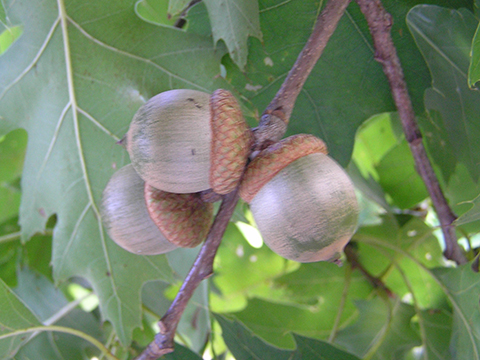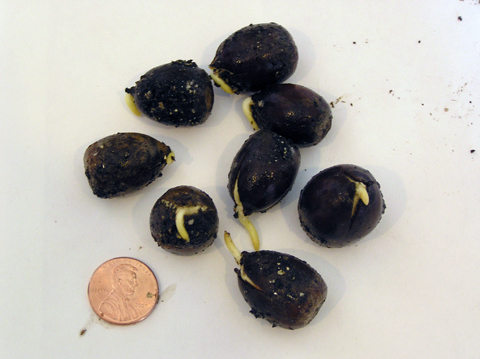 |
| Home | Ordering By Mail | Purchase Manual: Using Native Plants in Urban Landscapes |
|
|||||
Species Name: Quercus rubra, Quercus borealis
Common Name: Northern Red oak
Zone: 3 to 7
Distribution: Found from southern Quebec and Ontario, Canada south through the eastern US to Tennessee, extending westerly to Missouri in the south and Minnesota in the north.
Seed collection: Seed collection should begin in early September to late October in New York State. Seed production will vary considerably from year to year. Bumper crops are produced every 5 to 7 years with smaller crops or no crop at all produced during the intervening years. Acorn production is synchronized between all of the oak trees in entire regions so the lack of acorn production will be widespread. Open grown trees will produce fairly consistent acorn crops each year compared to forest grown trees. Acorns can be harvested directly from the tree or collected from the ground. Trees with low branches help facilitate collection directly from the tree and ensure a higher percentage of sound seed.
The acorns are mature when they naturally separate from the acorn cap. After the acorns mature they slowly dry breaking the bond with the cap. Sound acorns will be shiny with a bright color. Acorn color ranges from a dark green early in September to a reddish brown color at full maturity. Acorns that have fallen prematurely or have a cap firmly attached to them are usually not viable. Many species of insects feed on acorns both on the tree and on the ground. Insect feeding usually results in failure of the acorn to germinate.
Quercus rubra (QR) acorns produce their acorns over a two year period. The first year after pollination the acorn remains a tiny dormant bud that resembles a minute replica of the full size acorn. Next years acorn crop can be evaluated by looking at this years 1st year acorn buds.
Seed handling: After collection the acorns can be stored as is for up to one month. A float test can be used to separate sound viable seed from unsound seed. Many acorns will be infested with acorn weevil larvae. Float the acorns in a pail of water. Sound seeds will sink to the bottom while insect infested acorns will float or be semi-buoyant. Soaking the acorns in water for one to two days will kill any remaining insect larvae. Discard any acorns that float or have exit holes in them. Storage for longer than one month requires that the acorns maintain suitable moisture levels. Place the acorns in an equal portion of a moist potting mix and store where the seed is subjected to outside temperatures for cold/moist stratification. Caution, storage in a refrigerator will result in the acorns germinating after they have received sufficient chilling to break dormancy but often before outside conditions are suitable for planting. Place acorns stored outdoors in rodent proof containers to protect from rodents and squirrels.
Germination requirements: the acorns will begin to germinate after they have received sufficient cold treatment to germinate, usually 1 to 2 months. Under natural conditions cold temperatures over winter will satisfy the cold requirements and all of the viable acorns will germinate early the first spring. Acorns cannot be stored for longer than the period of time from fall to spring. A root radical will emerge as the acorn begins to sprout. The root will reach several inches in length and begin to establish lateral roots before the shoot shows signs of emerging. The root tip will follow the force of gravity. A word of caution, acorns that have sprouted in storage and are disturbed from their original position will develop twisted contorted roots as the root tip continually tries to follow gravity. Sow acorns 1” to 2” deep in prepared seed beds, individual containers or in natural soil. It is best to plant the acorn before it begins to sprout. Oak seedlings quickly convert the large amount of endosperm in the acorn into root that can reach 9” or more in depth. The deep root system helps the seedling cope with drought and competition from weeds but this also makes seedlings extremely difficult to dig and survive transplanting. As seedlings, the root system is far larger and more developed than the above ground shoot. For this reason it is best to plant acorns where you want them to grow and not try to transplant them. Grow oaks for transplanting in deep containers or root prune the roots one season before digging for ease of digging and transplant survival.
Quercus rubra seedlings will grow in full sun to half shade. Seedlings can be established in old fields, shrubland and young successional forest. Oak seedling establishment is best where herbaceous surface vegetation is sparse and shrubs and young trees are becoming established. Regeneration in established woodlands is seldom very successful or common because of insufficient light for good growth of the seedlings.
Ecology: Quercus rubra (QR) is a large long lived forest tree growing to a height of 70 to 90 ft high and 2 to 3 ft in trunk diameter. Quercus rubra commonly lives to an age of 200 to 300 years. QR is one of the fastest growing of all the oak species.
QR is an important economic species because of its high value lumber its wide geographic distribution and its frequency in many forest types. Red oak is quite adaptable to a range of soil types, moisture levels and pH . Red oak has become a tree of ecological importance in many forests types taking over the niche previously occupied by American chestnut. Where it is found it supplies a major part of the annual mast crop that many wildlife species depend on for winter survival.
Quercus rubra is dependant on the caching behavior of two key species for its successful germination and reproduction. Grey squirrels and Blue jays are both heavily dependant on acorn mast. Both species cache the acorns individually in the soil where they are relocated and eaten during the winter months. The placement of the acorns in the soils makes them ideally suited for germination if not retrieved. This process can be easily copied by humans. Acorns are planted in the soil 1 to 2 “ deep.

Red oak acorns ready for collection from tree.
As the acorns mature they will naturally separate from the cap
if viable.
The acorns will naturally fall to the ground when mature but it is best to collect from the tree if possible.

Root radicle emerging from acorn in early spring.
Root tip seeks gravity.
Acorns were stratified over the winter and given a chilling period to break dormancy.
Plant acorns before or as soon as acorn shows signs of germinating.
this page updated January 20, 2014